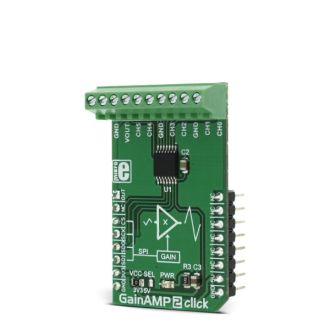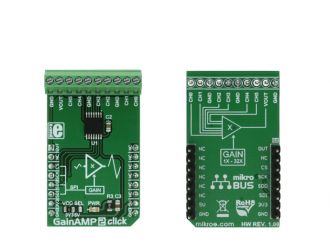
We strongly encourage users to use Package manager for sharing their code on Libstock website, because it boosts your efficiency and leaves the end user with no room for error. [more info]

Rating:
Author: MIKROE
Last Updated: 2018-03-13
Package Version: 1.0.0.0
mikroSDK Library: 1.0.0.0
Category: Amplifier
Downloaded: 6607 times
Not followed.
License: MIT license
GainAMP 2 click is a 6-channel programmable gain amplifier, used to amplify signals on any of the 6 non-inverting input channels up to 32x, in eight discrete steps.Â
Do you want to subscribe in order to receive notifications regarding "GainAMP 2 click" changes.
Do you want to unsubscribe in order to stop receiving notifications regarding "GainAMP 2 click" changes.
Do you want to report abuse regarding "GainAMP 2 click".


Library Description
The library carries a single function which allows complete control over GainAMP 2 click.
Key functions
gainamp2_writeCommand- Writes desired command data
Examples Description
The demo application shows the simplicity of usage.
The application is composed of two sections :
applicationInit()
{
gainamp2_spiDriverInit( (T_GAINAMP2_P)&_MIKROBUS1_GPIO, (T_GAINAMP2_P)&_MIKROBUS1_SPI );
// SETUP GAIN +4 on CHANNEL
gainamp2_writeCommand( _GAINAMP2_WRITE_INS | _GAINAMP2_CH, _GAINAMP2_CH4 );
gainamp2_writeCommand( _GAINAMP2_WRITE_INS | _GAINAMP2_GAIN, _GAINAMP2_GAIN_4X );
mikrobus_logWrite( "Channel 4 - aplified 4x", _LOG_LINE );
}
Additional notes and information
Depending on the development board you are using, you may need USB UART click, USB UART 2 click or RS232 click to connect to your PC, for development systems with no UART to USB interface available on the board. The terminal available in all MikroElektronika compilers, or any other terminal application of your choice, can be used to read the message.